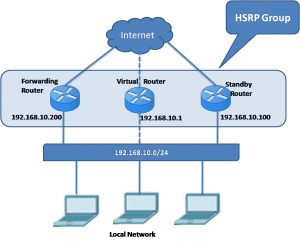What is FHRP? – Exclusive Explanation
When the active router fails, the First Hop Redundancy Protocol (FHRP) changes the standby router to an active router. If the active router fails, the standby router stops seeing Hello messages from the forwarding router.
Then, the standby router assumes the role of the forwarding router because it assumes both the IP and MAC addresses of the virtual router, and the host devices see no disturbance in service. This process is possible due to the First Hop Redundancy Protocols (FHRPs). The difference FHRPs are the following:-
Host Standby Router Protocol (HSRP)
It is a Cisco-proprietary First-Hop Redundancy Protocol (FHRP) planned to allow transparent failover of a first-hop IPv4 device. It allows configuring two or more routers as standby routers and only a single router as an active router at a time. This ensures high availability by providing first-hop routing redundancy for IPv4 hosts on networks configured with an IPv4 default gateway address.
All the routers in a single HSRP group share a single MAC address and IP address, which acts as a default gateway to the local network. It selects an active router and a standby router in the group.
The active roster forwards traffic to the network and sends the hello packet to the standby router. If it fails and the Standby router doesn’t receive a hello packet for three specific times, it takes up all the responsibilities of the active router and forwards the traffic.

HSRP for IPv6
This is also Cisco-proprietary FHRP, which is the same as HSRP. The difference is that HSRP works in an IPv4 environment, and HSRP for IPv6 works in IPv6 environments. An HSRP IPv6 group uses a virtual MAC address resulting from the HSRP group number and a virtual IPv6 link-local address.
Periodic router advertisements (RA) messages would be sent to the HSRP virtual IPv6 link-local address when the HSRP group is active. When the group becomes inactive for any reason, the Router Advertisement (RAs) messages stop after a final RA is sent when the group would be leaving the active state.
Virtual Router Redundancy Protocol Version 2 (VRRPv2)
Virtual Router Redundancy Protocol (VRRP) is an election protocol that provides redundancy to routers within a Local Area Network.
It is a non-proprietary protocol that allows several routers on a multi-access link to use the same virtual IPv4 address. VRRP was designed to remove a single point of failure in a static default-route environment by dynamically assigning virtual IP routers to participating hosts.
In a VRRPv2 configuration, one router is elected as the virtual router master, and other routers act as backups if the master fails.
A virtual router is a collection of physical routers whose interfaces must belong to the same IP subnet. Each virtual router is assigned a virtual router ID, but there is no restriction against reusing a VRID with a different address mapping on different LANs.
VRRPv3
VRRPv3 supports IPv6 addresses, including IPv4 addresses, for dual-stack networks configured with VRRP or VRRP-E. It is compliant with RFC 5798. It provides a faster switchover to backup devices than can be achieved using standard IPv6 neighbor discovery mechanisms.
With VRRPv3, a backup router can become a master router only in seconds with less overhead traffic and no relations with the hosts. It works in multi-vendor environments and is more scalable than VRRPv2.
Gateway Load Balancing Protocol (GLBP)
GLBP is the Cisco-proprietary FHRP. It is the abbreviation of the Gateway Load Balancing Protocol, which protects data traffic from a failed router or circuit, like HSRP and VRRP. GLBP also allows load sharing between a group of redundant routers.
GBLP is specially designed to overcome the limitations of HSRP and VRRP. Gateway Load Balancing Protocol’s additional feature is loading share between the gateways. In HSRP and VRRP, the standby routers are configured for redundancy and act as standby only, becoming active only when the active router fails.
GLBP for IPv6
It is also a Cisco-proprietary FHRP that provides the same function as GLBP but in an IPv6 environment. It provides automatic router backup for IPv6 hosts configured with a single default gateway on a LAN. Multiple first-hop routers on the local area network join to offer a single virtual first-hop IPv6 router while sharing the IPv6 packet forwarding load.
ICMP Router Discovery Protocol (IRDP)
RFC 1256 specifies it as a legacy FHRP. The ICMP Router Discovery Protocol (IRDP) allows IPv4 hosts to locate routers that provide IPv4 connectivity to nonlocal IP networks.
It uses Internet Control Message Protocol (ICMP) router advertisements and router solicitation messages to allow a host to discover the addresses of operational routers on the subnet.
FAQs
Q1: What is a First Hop Redundancy Protocol (FHRP)?
A1: FHRP is a computer networking protocol designed to ensure the availability of a default gateway in a network. It allows multiple routers to provide backup for a single IP address, ensuring continuous network availability even if one router fails.
Q2: Why is FHRP important in networking?
A2: FHRP is crucial because it provides redundancy and high availability for the default gateway, essential for maintaining network connectivity and minimizing downtime in case of router failures.
Q3: What are the common types of FHRP?
A3: The most common types of FHRP include:
- Hot Standby Router Protocol (HSRP)
- Virtual Router Redundancy Protocol (VRRP)
- Gateway Load Balancing Protocol (GLBP)
Q4: How does HSRP work?
A4: HSRP works by creating a virtual router with a virtual IP address and MAC address. Multiple routers participate in the HSRP group, one acting as the active router and another as the standby router. If the active router fails, the standby router takes over the virtual IP address, ensuring continuous network service.
Q5: What is the difference between HSRP and VRRP?
A5: While both HSRP and VRRP provide redundancy for the default gateway, their implementation and standards differ. HSRP is a Cisco proprietary protocol, whereas VRRP is an open standard protocol defined by the IETF. Additionally, VRRP allows multiple routers to share the load, whereas HSRP typically has one active and one standby router.
Q6: Can FHRP protocols be used together?
A6: FHRP protocols can be used together in a network to enhance redundancy and load balancing. For example, HSRP can be used with GLBP to provide redundancy and load balancing.
Q7: What are the benefits of using GLBP?
A7: GLBP provides load balancing in addition to redundancy. It allows multiple routers to share the network traffic load, improving overall network performance and resource utilization.
Q8: How do I configure FHRP on my network?
A8: Configuring FHRP involves setting up the protocol on your routers, assigning virtual IP addresses, and defining priority levels for the routers. The specific configuration steps vary depending on the protocol (HSRP, VRRP, or GLBP) and the network equipment used.
Q9: What are some common issues with FHRP, and how can they be resolved?
A9: Common issues with FHRP include misconfigurations, network topology changes, and hardware failures. These can be resolved by verifying configuration settings, ensuring proper network design, and regularly monitoring and maintaining network equipment.
Q10: Where can I find more information about FHRP?
A10: More information about FHRP can be found in networking textbooks, online resources, and vendor documentation from companies like Cisco. Additionally, the original article on NetworkUstad provides a detailed overview of FHRP.
